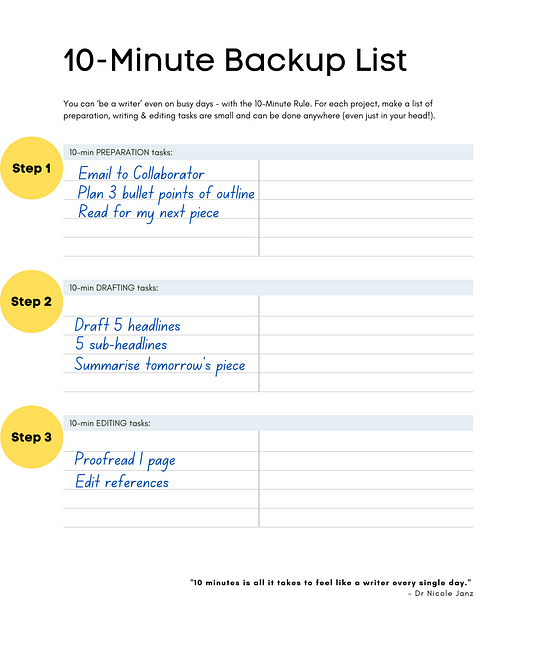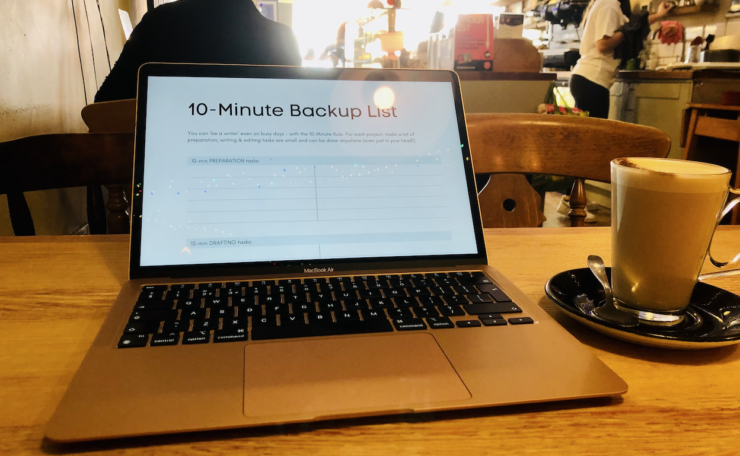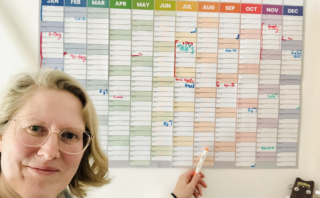In a world of busy schedules, most writers think they need at least a 2-hour block to write — or a whole weekend!
I used to be like that. If my day was full, I gave up on my writing and told myself I didn’t have any time. But that was a lie.
I did have at least 10 minutes throughout the day that I could have used for tiny tasks. Over the last years, I’ve probably wasted weeks and even months by “waiting” for a long stretch to write.
Until I created the 10-Minute Rule.
By using the 10-minute rule, you let go of too high expectations and start using small pockets of time productively. Because in reality, there are many small tasks related to your writing that take less than 10 minutes and help you move forward.
Here’s the rule:
Don’t say: “I don’t have time to write”
Do say: “Today, I will spend at least 10 minutes on my project.”
Here’s how to apply this to your writing life with a “10-Minute List”.
For writers, 10-minute tasks generally fall into 3 categories:
(1) Preparing
(2) Drafting
(3) Editing
Let’s create your own task list in 3 simple steps. Think of your current top 1–2 writing projects and get pen and paper ready.
Step 1: List 10-minute preparation tasks
Preparation tasks are anything you need before you start typing your ‘actual’ text (they can be in your head, too).
For example,
- Thinking (in the shower, on school run, while waiting in a queue)
- Outline your next article or chapter
- Mind mapping
- Outline an article
- Taking notes
- Reading
- Email to a collaborator
- Free-Writing (free flow writing) to generate ideas
- Goal Setting for your writing week
What could be preparation, thinking or planning tasks for your particular writing project? Jot them down.
Step 2: List 10-minute drafting tasks
This is producing words for your actual content, and it doesn’t matter ‘where’ you write these words.
For example,
- Write one paragraph in your journal
- Type the intro for your blog into your phone (I use the Apple “notes” app)
- Draft a ‘shitty’ abstract for your article, 200 words
What tiny writing tasks could you do within 10 minutes? Make a list of 3–5 items.
Step 3: List 10-minute editing tasks
Finally, you can make a list of editing tasks.
For example,
- Check if your article flows well
- Highlight where more references or examples are needed
- Proofread two pages for typos
- Read your newsletter one more time, then schedule it
What editing task would take only 10 minutes for you?
Here’s an example:

When do you apply the 10-Minute Rule?
I used to think that these are “backup” tasks, so I mainly used them when I had gaps in my calendar.
But I noticed they were also useful for my longer writing sessions (where I had 2 hours at least). To help myself ease into the writing session, I started using my 10-Minute list — and indeed, I removed fear and block and instead got a few dopamine hits from ticking off simple tasks.
So here’s how I recommend you use this list:
- at the start of a longer writing session to find your way in
- if suddenly 10 minutes free up in your day
- during wait times in traffic (you can at least think!), when you drive your kids to their hobby activities (and wait in the car), etc.
To make this a truly effective list, keep it handy on your phone, in your head, at your desk etc.
How to establish the 10-Minute Rule as a new habit
To make this new tool part of your writing habit, you need to update and apply your list regularly. I would attach this to your weekly planning process to make sure you don’t forget it.
- Create your 10-Minute List and have it ready (on your phone, laptop, in your notebook, planner, etc.)
- Reserve at least one 10min slot per day for a whole week to practice this approach
- Keep ticking off your list to enjoy a dopamine hit
- Reflect on this process and improve it for the following week, until you found a way to tailor this tool to how, when and where you write
In my experience, preparation tasks are the easiest to start with.
I have such lists on my “notes” app which synchronies between my laptop and phone. I also have journals that I like to have with me, and sometimes I take a photo of my backup list in my planner.
The beauty is that on busy days where you only have 10 minutes for your writing project, you can fall back on your 10-Minute List instead of having to come up with a tiny task on the spot.
It becomes easy to engage with your writing. And that makes it much more motivating to move forward.





